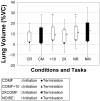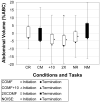Effect of cues to increase sound pressure level on respiratory kinematic patterns during connected speech
- PMID: 17538105
- PMCID: PMC3433495
- DOI: 10.1044/1092-4388(2007/044)
Effect of cues to increase sound pressure level on respiratory kinematic patterns during connected speech
Abstract
Purpose: This study examined the response of the respiratory system to 3 cues used to elicit increased vocal loudness to determine whether the effects of cueing, shown previously in sentence tasks, were present in connected speech tasks and to describe differences among tasks.
Method: Fifteen young men and 15 young women produced a 2-paragraph reading passage in response to 4 different loudness cues: comfortable loudness level, targeting 10 dB above comfortable, at what they perceived as twice their comfortable loudness, and with multitalker noise present in the background. A short monologue was produced at comfortable loudness level and with noise in the background.
Results: Differences in respiratory strategies were demonstrated for the different cueing conditions, similar to patterns observed in sentence productions. The kinematic patterns were similar for reading and monologue; however, utterances were longer and speaking rate was slower in the monologue task.
Conclusion: The findings extend the results from sentences to connected speech and provide support for the hypothesis that "intention" or goals play a role in the control of respiratory function during speech. Respiratory kinematics were similar across tasks, when the same cue was used, except for differences related to breath group length and speech rate.
Figures




Similar articles
-
Effects of utterance length and vocal loudness on speech breathing in older adults.Respir Physiol Neurobiol. 2008 Dec 31;164(3):323-30. doi: 10.1016/j.resp.2008.08.007. Epub 2008 Aug 28. Respir Physiol Neurobiol. 2008. PMID: 18790093 Free PMC article.
-
Effects of increasing sound pressure level on lip and jaw movement parameters and consistency in young adults.J Speech Lang Hear Res. 2006 Dec;49(6):1368-79. doi: 10.1044/1092-4388(2006/098). J Speech Lang Hear Res. 2006. PMID: 17197502 Free PMC article.
-
Effects of loudness cues on respiration in individuals with Parkinson's disease.Mov Disord. 2007 Apr 15;22(5):651-9. doi: 10.1002/mds.21375. Mov Disord. 2007. PMID: 17266087 Free PMC article.
-
Changes to respiratory mechanisms during speech as a result of different cues to increase loudness.J Appl Physiol (1985). 2005 Jun;98(6):2177-84. doi: 10.1152/japplphysiol.01239.2004. Epub 2005 Feb 10. J Appl Physiol (1985). 2005. PMID: 15705723 Free PMC article. Clinical Trial.
-
Control of vocal loudness in young and old adults.J Speech Lang Hear Res. 2001 Apr;44(2):297-305. doi: 10.1044/1092-4388(2001/024). J Speech Lang Hear Res. 2001. PMID: 11324652
Cited by
-
Computational simulations of respiratory-laryngeal interactions and their effects on lung volume termination during phonation: Considerations for hyperfunctional voice disorders.J Acoust Soc Am. 2021 Jun;149(6):3988. doi: 10.1121/10.0005063. J Acoust Soc Am. 2021. PMID: 34241462 Free PMC article.
-
Impact of typical aging and Parkinson's disease on the relationship among breath pausing, syntax, and punctuation.Am J Speech Lang Pathol. 2012 Nov;21(4):368-79. doi: 10.1044/1058-0360(2012/11-0059). Epub 2012 Jul 30. Am J Speech Lang Pathol. 2012. PMID: 22846880 Free PMC article.
-
Restoration Strategies Following Short-Term Vocal Exertion in Healthy Young Adults.J Speech Lang Hear Res. 2021 Jul 16;64(7):2472-2489. doi: 10.1044/2021_JSLHR-20-00713. Epub 2021 Jun 12. J Speech Lang Hear Res. 2021. PMID: 34121423 Free PMC article.
-
Increased vocal intensity due to the Lombard effect in speakers with Parkinson's disease: simultaneous laryngeal and respiratory strategies.J Commun Disord. 2014 Mar-Apr;48:1-17. doi: 10.1016/j.jcomdis.2013.12.001. Epub 2013 Dec 28. J Commun Disord. 2014. PMID: 24438910 Free PMC article.
-
Effects of utterance length and vocal loudness on speech breathing in older adults.Respir Physiol Neurobiol. 2008 Dec 31;164(3):323-30. doi: 10.1016/j.resp.2008.08.007. Epub 2008 Aug 28. Respir Physiol Neurobiol. 2008. PMID: 18790093 Free PMC article.
References
-
- Bode FR, Dosman J, Martin RR, Ghezzo H, Macklem PT. Age and sex differences in lung elasticity, and in closing capacity in nonsmokers. Journal of Applied Physiology. 1976;41:129–135. - PubMed
-
- Boersma P, Weenink D. Praat (Version 4.1) Institute of Phonetic Sciences; Amsterdam: 2003.
-
- Dromey C, Ramig LO. Intentional changes in sound pressure level and rate: Their impact on measures of respiration, phonation, and articulation. Journal of Speech, Language, and Hearing Research. 1998;41:1003–1018. - PubMed
-
- Finnegan EM, Luschei ES, Hoffman HT. Modulations in respiratory and laryngeal activity associated with changes in vocal intensity during speech. Journal of Speech, Language, and Hearing Research. 2000;43:934–950. - PubMed
-
- Gentilucci M, Benuzzi F, Bertolani L, Daprati E, Gangitano M. Language and motor control. Experimental Brain Research. 2000;133:468–490. - PubMed
Publication types
MeSH terms
Grants and funding
LinkOut - more resources
Full Text Sources
Miscellaneous

